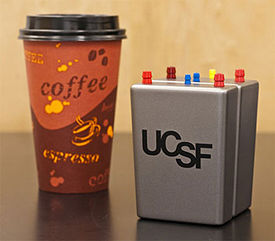Dialysis, by Kyle Reed: Difference between revisions
Kyle J. Reed (talk | contribs) |
Kyle J. Reed (talk | contribs) No edit summary |
||
| Line 1: | Line 1: | ||
== Background == | == Background == | ||
[[Image:Nephron.jpg|right|thumb|275px|Figure 1. Diagram of a nephron and the processes [X] ]] | [[Image:Nephron.jpg|right|thumb|275px|Figure 1. Diagram of a nephron and the processes [X] ]] | ||
| Line 31: | Line 77: | ||
[[Image:KolffPostage.jpg|right|thumb|275px|Figure 3. Kolff's first dialysis machine on a Dutch stamp [X] ]] | [[Image:KolffPostage.jpg|right|thumb|275px|Figure 3. Kolff's first dialysis machine on a Dutch stamp [X] ]] | ||
| Line 64: | Line 156: | ||
===Peritoneal Dialysis=== | ===Peritoneal Dialysis=== | ||
| Line 101: | Line 218: | ||
Figure 6 shows the global market for dialysis as of January 2013. The "Rest of World" portion has been amplified with the growing market in India. Currently, there are 52,000 Indian patients on dialysis, but this is no where near the amount of people that require it. While dialysis in India costs 4 to 33 percent of the cost in the U.S., more then 90 percent of the 230,000 that develop chronic kidney failure each year are unable to acquire treatment [12]. | Figure 6 shows the global market for dialysis as of January 2013. The "Rest of World" portion has been amplified with the growing market in India. Currently, there are 52,000 Indian patients on dialysis, but this is no where near the amount of people that require it. While dialysis in India costs 4 to 33 percent of the cost in the U.S., more then 90 percent of the 230,000 that develop chronic kidney failure each year are unable to acquire treatment [12]. | ||
== References == | == References == | ||
Revision as of 17:07, 6 February 2013
Background

History


Current Technology
Hemodialysis

Peritoneal Dialysis
Future of Dialysis


Nephron Regeneration
Artificial Kidney
Impact
It is apparent that the both of the research approaches described above can have a drastic impact on the lives of those that require dialysis. Whether it be allowing them to regrow an entire kidney, or have an artificial one instead, it would allow people to live their lives without the worries of having to spend countless hours near a dialysis machine to survive. However, these technologies could prove to be even more important for those that are not even able to have dialysis due to financial restrictions.
Figure 6 shows the global market for dialysis as of January 2013. The "Rest of World" portion has been amplified with the growing market in India. Currently, there are 52,000 Indian patients on dialysis, but this is no where near the amount of people that require it. While dialysis in India costs 4 to 33 percent of the cost in the U.S., more then 90 percent of the 230,000 that develop chronic kidney failure each year are unable to acquire treatment [12].
References
X. Space Biomedical Research Institute. http://home.bway.net/rjnoonan/humans_in_space/fluid.html (accessed February 6, 2013).
X. The Kidney Doctor. http://www.thekidneydoctor.org/2012/02/remembering-willem-kolff.html (accessed February 6, 2013).
X. Saltzman, W. Tissue Engineering: Principles for the Design of Replacement Organs and Tissues; Oxford: New York, 2004; pp. 387-391.
X. Ratner, B.D.; Hoffman, A.S.; Schoen, F.J.; Lemons, J.E. Biomaterials Science: An Introduction to Materials in Medicine, 2nd ed.; Elsevier Academic Press: San Diego, 2004; pp. 514-518.
X. VascularWeb. http://www.vascularweb.org/vascularhealth/Pages/dialysis-access.aspx (accessed February 6, 2013).
X. Advanced Renal Education Program. http://www.advancedrenaleducation.com/Hemodialysis/HistoryofHemodialysis/tabid/177/Default.aspx (accessed February 6, 2013).
X. DaVita. http://www.davita.com/kidney-disease/dialysis/motivational/the-history-of-dialysis/e/197 (accessed February 6, 2013).
X. $100 Dialysis. http://100dialysis.wordpress.com/2012/01/24/a-brave-beginning/ (accessed February 6, 2013).
[9] Diep, C.Q.; Ma, D.; Deo, R.C.; Holm, T.M.; Naylor, R.W.; Arora, N.; Wingert, R.A.; Bollig, F.; Djordjevic, G.; Lichman, B.; Zhu, H.; Ikenaga, T.; Ono, F.; Englert, C.; Cowan, C.A.; Hukriede, N.A.; Handin, R.I.; Davidson, A.J. Identification of adult nephron progenitors capable of kidney regeneration in zerbrafish. Nature. 2011, 470, 95-100.
[10] Ronco, C.; Davenport, A.; Gura, V. A wearable artificial kidney: dream or reality?. Nature Clinical Practice. 2008, 4, 604-605.
[11] medGadget. http://www.medgadget.com/2012/11/an-implantable-artificial-kidney-interview-with-ucsfs-dr-shuvo-roy.html (accessed February 6, 2013).
[12] The Kidney Doctor. http://www.thekidneydoctor.org/2013/01/global-nephrology-dialysis-in-india.html (accessed February 6, 2013).